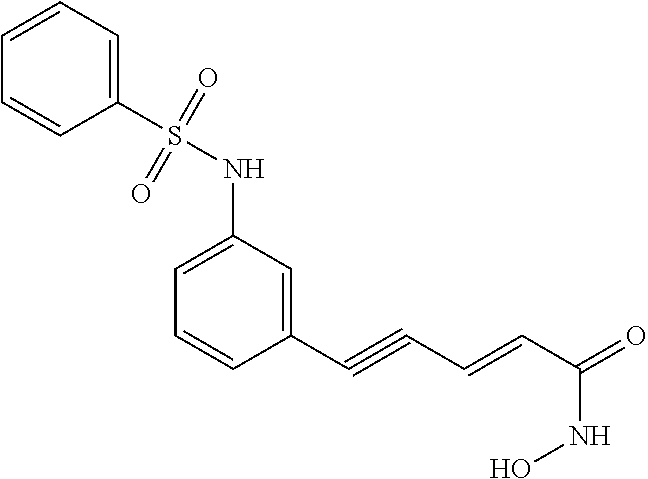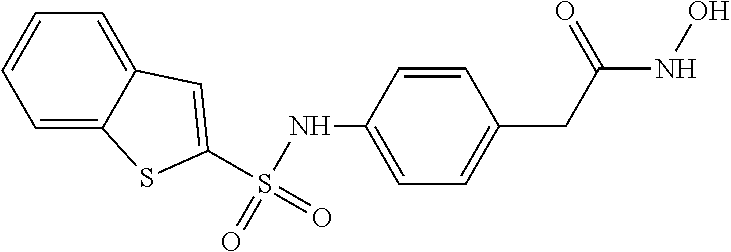5-lipoxygenase inhibitors
a technology of lipoxygenase inhibitors and inhibitors, which is applied in the direction of biocide, plant growth regulators, animal husbandry, etc., can solve the problems of insufficient therapeutic duration, toxic compounds, and no effective cancer treatment incorporating a 5-lipoxygenase inhibitor has been approved, etc., to achieve potent 5-lipoxygenase inhibitory activity, excellent pharmaceutical stability, and good biological profil
- Summary
- Abstract
- Description
- Claims
- Application Information
AI Technical Summary
Benefits of technology
Problems solved by technology
Method used
Image
Examples
example 1
[0175]
[0176]4-Iodoaniline (11 g) was dissolved in dichloroethane (150 ml). Triethylamine (20 ml) was added and the mixture cooled to 0-5° C. 4-Chlorobenzensulphonyl chloride (16 g) was added in potions over 1 h. After a further 1 h, the mixture was washed with dilute hydrochloric acid, the DCE layer separated and dried. After removal of the solvent and treating the residue with isopropyl ether, 16.5 g coupled product was obtained.
[0177]The iodide (7.9 g) was mixed with butyn-2-ol (2 g), copper (I) iodide (250 mg), tetra-kis-triphenyl phosphine Pd (0) (0.5 g) and ethyl acetate (40 ml) under nitrogen. Triethylamine (6 ml) was added, during which time the solids dissolved and there was an exotherm. After 1 h (complete reaction) the mixture was washed with dilute HCl and the solution was dried over magnesium sulphate. After filtration (also removes Cu salts), the solvent was removed and the crude product triturated with isopropyl ether to give the product (6.5 g).
[0178]The alcohol (3 g)...
example 2
[0183]The olefinic compounds may be prepared as shown below:
[0184]The iodide (4 g), triethylamine (2.5 ml), palladium acetate (230 mg), triphenyl phosphine (0.52 g) and the olefin (2.5 g-prepared by a Mitsunobu reaction between the alcohol and bis-acetyl hydroxylamine) were dissolved in acetonitrile (15 ml) and DMF (4 ml) and warmed to reflux for 4 h. The solvent was removed and replaced by toluene (20 ml). After washing with dilute HCl, the toluene was removed and replaced with methanol (10 ml). Sodium hydroxide (1 ml, 18M) was added and the mixture stirred for 1h. The methanol was removed, water added and the aqueous washed with diethyl ether. After acidification, the aqueous layer was extracted with DCM. After drying, the solvent was removed and the residue purified by chromatography (ethyl acetate) to give 62 mg product as a glass.
example 3
[0185]The following experimental sets out a procedure, as a non-limiting illustration, for preparing ‘reverse sulfonamide’ (relative to Examples 1 and 2) linked (L1) acetylene linked (L2) hydroxamic acid derivatives according to the present invention.
Stage 1
[0186]
3-bromo-N-(4-fluorophenyl)benzenesulfonamide
[0187]3-Bromobenzene sulphonyl chloride (25.5 g, 0.1 mole) is dissolved in dichloromethane (150 ml) and sodium bicarbonate added (17 g, 0.2 mole). 4-Fluoroaniline (22.6 g, 0.2 mole) is added and the mixture stirred overnight. Water is added and the DCM phase separated, washed twice with 100 ml 3M HCl. The solution is dried and the solvent removed to afford the crude sulphonamide in essentially quantitative yield.
Stage 2
[0188]
N-(4-fluorophenyl)-3-(3-hydroxybut-1-yn-1-yl)benzenesulfonamide
[0189]The crude stage 1 product is dissolved in DMF (250 ml) and copper (I) iodide (1 g) is added. Triethylamine (21 ml, 1.5 eq) is added followed by 3-butyn-2-ol (11 ml, 1.5 eq). The mixture is wa...
PUM
| Property | Measurement | Unit |
|---|---|---|
| purity | aaaaa | aaaaa |
| structure | aaaaa | aaaaa |
| pharmaceutical stability | aaaaa | aaaaa |
Abstract
Description
Claims
Application Information
 Login to View More
Login to View More - R&D
- Intellectual Property
- Life Sciences
- Materials
- Tech Scout
- Unparalleled Data Quality
- Higher Quality Content
- 60% Fewer Hallucinations
Browse by: Latest US Patents, China's latest patents, Technical Efficacy Thesaurus, Application Domain, Technology Topic, Popular Technical Reports.
© 2025 PatSnap. All rights reserved.Legal|Privacy policy|Modern Slavery Act Transparency Statement|Sitemap|About US| Contact US: help@patsnap.com



